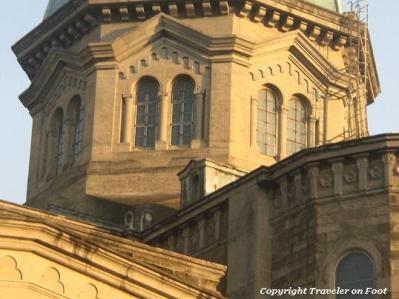

A victim of natural calamities and the last great world war, the Manila Cathedral is the 8th cathedral to be constructed on its present location. Known as the Minor Basilica de la Inmaculada Concepcion, the Manila Cathedral was the seat of the Archbishop of Manila from the time of the Spanish Colonial Period up to the present.
The present Manila Cathedral was designed by Fernando Ocampo. Ocampo applied striking mix of Renaissance, Neo-Romanesque and Neo-Byzantine motifs in building the new Cathedral. The new Manila Cathedral was blessed and inaugurated on feast day of the Immaculate Concepcion, December 8, 1958.
The statues on the façade
The façade is graced by statues of famous saints sculpted by Italian artists in Roman travertine stone. The statues of the old cathedral were made of molave (a Philippine hardwood).

The saints are: (Top) to the left is Santa Rosa de Lima, patroness of the Philippines by Angelo Fattinanzi and to the right is St. Jacob the Great. (Bottom) Starting from left is San Andres, preacher of the faith in many corners of Asia and patron saint of Manila by Lavia Papini, San Francisco Xavier, apostle of the Indies by Alcide Tico, Santo Policarpio, old bishop of Smryrna also by Alcide Tico and San Antonio, Abbot and founder of Oriental monasticism by Lavia Papini.
Eclectic design
Ocampo incorporated a combination of Renaissance, Neo-Romanesque and Neo-Byzantine motifs. The pre-cast ornaments which appear like carvings in stone were designed and executed by artist Jose Pablo.
Elements of Renaissance design are represented by the pineapple finials and lanterned dome supported by the drum.


Arcaded portals and semi-circular arches, stylized acanthus leaves, rosettes, lentils, stars and attached columns are some characteristics of Neo-Romanesque and Neo-Byzantine architecture.


Rose Glass Window

The rose glass window on the façade is by artist Galo Ocampo. The window is divided into twelve rays as a symbol of the twelve apostles. The frame is of Neo-Romanesque style.The original 16-ray rose glass window of the 1879 façade of the old Cathedral was destroyed during the 1945 Liberation.
The Main Portal
Beneath the rose glass window is the main portal executed in eight bronze panels by Italian sculptor Alessandro Monteleone and Francesco Nagni. Each bronze panel show artistic relief representation of the important episodes of the history of the Manila Cathedral.


From left to right panel beginning from top shows, (1) Bishop Domingo Salazar, the first bishop of Manila blesses the original church in 1597; (2) The cathedral of nipa and bamboo on fire in 1583; (3) Collapse of the first stone church during the 1600 earthquake; (4) Bishop Diego Vasquez de Mercado consecrates the rebuilt of cathedral in 1614; (5) Nipa hut served as interim cathedral after the 1645 earthquake; (6) Archbishop Miguel de Poblete collects offering for the reconstruction; (7) The tragedy brought by the 1863 earthquake which killed Cathedral cannons including the propagandist Padre Pedro Pelaez; and (8) Destruction brought about by the 1945 war.


[…] to the Traveler on Foot, the reliefs were executed in eight bronze panels by Italian sculptors Alessandro Monteleone and […]
Hopefully, our beloved Cathedral would be preserved well.
[…] Acknowledgements as well to the book Ciudad Murada by the Intramuros Administration and Traveler on Foot […]
[…] to the Traveler on Foot the reliefs were executed in eight bronze panels by Italian sculptor Alessandro Monteleone and […]
[…] So we took a taxi via Roxas Boulevard. Across the huge limestone walls of Intramuros loomed the Manila Cathedral with its gray walls and blue roof. Unmistakable. We entered the walled city and paid our P90 […]